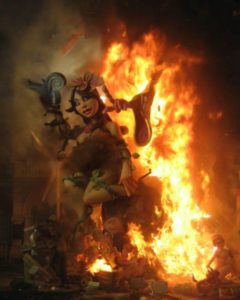 Las Fallas es la denominación popular de las fiestas en honor a San José, patrón de los carpinteros. Está catalogada como fiesta de Interés Turístico Internacional. Son construcciones artísticas de materiales combustibles, con figuras conocidas como ninots y composiciones de elementos. Sus orígenes son realmente sencillos, una simple quema de desechos de los talleres de carpintería.
Las Fallas es la denominación popular de las fiestas en honor a San José, patrón de los carpinteros. Está catalogada como fiesta de Interés Turístico Internacional. Son construcciones artísticas de materiales combustibles, con figuras conocidas como ninots y composiciones de elementos. Sus orígenes son realmente sencillos, una simple quema de desechos de los talleres de carpintería.
En esta fiesta se unen varios aspectos que definen una cultura: el fuego, la música, la pólvora, y la calle. Casi en cada calle de la ciudad hay un Casal Faller, que durante todo el año busca fuentes de ingresos para poder pagar la fiesta y su propio monumento. Desde el día 15 hasta el 19 de marzo, los días y noches en Valencia son una fiesta continua. Pero ya desde el día 1 se hacen mascletàs: espectáculo de petardos y fuegos artificiales, en el que se obtienen composiciones musicales a través del ruido de los cañones de pólvora.
Las fallas se clasifican en categorías ordenadas por presupuesto: Especial, Primera [A,B], Segunda [A,B],Tercera [A,B,C]…, Séptima C), y dentro de cada categoría se organiza un concurso en el que se elige la mejor falla, valorándose la monumentalidad, el riesgo, la temática, el colorido, etcétera.
También se elige el mejor muñeco, que resulta indultado y se salvará de la hoguera. Las fallas suelen tener varios metros de altura (hasta 25 ó 30 metros) y están compuestas de numerosas figuras de cartón piedra sostenidas por un armazón de madera. Se instalan en la calle el día 15 de marzo por la noche, el día de la plantà.
Últimamente, y debido a las dimensiones de algunas, el acto se adelanta varios días y necesita de la ayuda de grúas. A la quema de la falla se llama la cremà.
The Fallas is the popular name of the festivities to honour San José, patron saint of the carpenters. It has been declared of International Tourist Interest.
Las Fallas refer to artistic constructions made out of combustible materials, with figure known as ninots, and compositions of elements. It has a very humble origin, a simple burning of waste from carpentry workshops. This festivity combines different aspects that define a type of culture: fire, music, gunpowder, and the street. Almost on every street in the city there is a Casal Faller, a group of people which hold fundraising activities throughout the year to be able to pay for the construction of their own falla.
From the 15th to the 19th of March, the days and nights in Valencia are a constant party. From the first day they make mascletàs: show of firecrackers and fireworks that produce musical compositions through the noise of gunpowder guns.
Las Fallas are classified into categories according to budget (First [A, B], Second [A, B], Third[A, B, C] …, Seventh C), and within each category a contest is organized and the best falla is chosen, considering the monumentality, the risk, the topic, the colour, etcetera. The best figure is also chosen and saved from the stake.
Las fallas are usually several metres in height (up to 25 or 30 metres) and are composed of numerous figures of papier-mache supported by a wooden frame. They are installed in thestreet on March the 15th at night (the day of the plantà). Lately, due to the dimensions of some of these constructions, the celebration is brought forward several days and needs the help of cranes. The burning of it all is called the cremà.